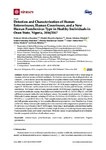Detection and Characterization of Human Enteroviruses, Human Cosaviruses, and a New Human Parechovirus Type in Healthy Individuals in Osun State, Nigeria, 2016/2017
Abiodun Osundare, Folakemi
Oluyinka Opaleye, Oladele
Abiodun Akindele, Akeem
Adeyinka Adedokun, Samuel
Anuoluwapo Akanbi, Olusola
Bock, Claus-Thomas
Diedrich, Sabine
Böttcher, Sindy
Human enteroviruses and human parechoviruses are associated with a broad range of diseases and even severe and fatal conditions. For human cosaviruses, the etiological role is yet unknown. Little is known about the circulation of non-polio enteroviruses, human parechoviruses, and human cosaviruses in Nigeria. A total of 113 stool samples were collected from healthy individuals in Osun State between February 2016 and May 2017. RT-PCR assays targeting the 5′ non-coding region (5′ -NCR) were used to screen for human enteroviruses, human parechoviruses, and human cosaviruses. For human enteroviruses, species-specific RT-PCR assays targeting the VP1 regions were used for molecular typing. Inoculation was carried out on RD-A, CaCo-2, HEp-2C, and L20B cell lines to compare molecular and virological assays. Ten samples tested positive for enterovirus RNA with 11 strains detected, including CV-A13 (n = 3), E-18 (n = 2), CV-A20 (n = 1), CV-A24 (n = 1), EV-C99 (n = 1), and EV-C116 (n = 2). Three samples tested positive for human parechovirus RNA, and full genome sequencing on two samples allowed assignment to a new Parechovirus A type (HPeV-19). Thirty-three samples tested positive for cosavirus with assignment to species Cosavirus D and Cosavirus A based on the 5′-NCR region. Screening of stool samples collected from healthy individuals in Nigeria in 2016 and 2017 revealed a high diversity of circulating human enteroviruses, human parechoviruses, and human cosaviruses. Molecular assays for genotyping showed substantial benefits compared with those of cell-culture assays.

